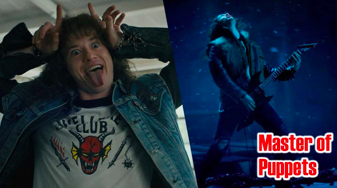Stranger Things, Metallica and Art: Music to The Ears and The Eyes.
Nowadays, if you were to walk into any room and ask, “Who here has seen ‘Stranger Things?’” It’s pretty likely that most hands in the room will go up. There’s no doubt that the nostalgic stylization of 80s culture was an instant hit.
Watching season four of “Stranger Things” did not disappoint. The second-to-last season impressed many with the integration of classic rock and metal into the show. The song choices throughout the series fascinated metal-heads everywhere. Unfortunately, metal music historically has gotten a bad rap, but metal-heads stand by the iconic riffs and rumbles. With the “Stranger Things” craze going strong, metal is coming back into the spotlight. Yes, we are talking about the one and only, Metallica.
You could imagine the enthusiasm when one of Metallica’s many gems blasted within the season’s momentous conclusion. The song “Master of Puppets” graces us with a lively dance of thrash metal guitar, and vocals that are louder than loud. Actor Joseph Quinn (Eddie Munson), even played these iconic riffs himself in the season four finale. Since the season four premiere, this chaotic introduction to metal has jump started the viewers’ hearts, cultivating curiosity about Metallica as a whole.
What’s with all this talk about puppets?
“Master of Puppets” is widely known as one of Metallica’s most successful albums. Written by band members Cliff Burton, Kirk Hammett, Lars Ulrich, James Hetfield, and released in 1986 by Elektra Records, the album undeniably made its mark. This concoction of ingenious melodies and socially rebellious lyrics quickly became #29 on the U.S Billboard 200, and still is repeatedly ranked as one of the top metal albums ever made. One may hear the title “Master of Puppets” and think of innocent felt figures dancing across a stage, but the true meaning is far from innocent. According to lead vocalist James Hetfield, “Master of Puppets” is actually about drug addiction.
“Master of Puppets” deals pretty much with drugs. How things get switched around, instead of you controlling what you’re taking and doing its drugs controlling you. Like, I went to a party here in S.F., there were all these freaks shooting up and geezin' and this other girl was real sick.” —James Hetfield
Pretty heavy stuff right? It is widely known that the music industry is no stranger to substance abuse. Metal sounds angry, but its history runs deep within society. Metal screams empowerment, rage and perseverance, all of which are shown not only in Metallica’s music, but in its art as well.
What’s art got to do with it?
Album covers have forever been the pinnacle of “curb appeal” for musicians. A good album grabs the attention of the listener by not just their ears, but by their eyes as well. A vinyl on the shelf with an intriguing appearance and eye-catching color presents an instantaneous first impression of what you can expect from its music. Walking through a record store, it’s pretty easy to point out which albums are going to blow your eardrums with some heavy guitar. The most iconic covers are seen everywhere in media spreading across the musical masses.
Metallica’s “Master of Puppets” album cover is no different. The hard, jagged font followed by dark and ambiguous motifs is really what makes this artwork great. The crosses portray a certain morbidity that sticks with you even when you look away. Even the color choice is meticulous. Studies on color theory have concluded that orange actually increases energy levels, perfect for a metal album.
Some of the smaller aspects of the cover are the faint hands in the sky, and the puppet strings attaching to every cross. These details add a new level of intention to the artwork, differentiating this album cover from a simple painting of a cemetery. If you showed people this album cover without the coveted “Metallica” title, people would still know it’s Metallica. The band boasts an iconic style with bold colors, polished graphic art and aggressive imagery.
The puppeteers playground
Who do we thank for this monumental album cover? His name is Don Brautigam. This impactful artist truly left his mark. If you look closely, you can see the initials “D.B” in the bottom right corner of the album cover.
Brautigam’s portfolio was filled with album covers for metal bands like Anthrax, ACDC, Motley Crue and most importantly, Metallica. According to Louder, the drawing was created by Brautigam, Hetfield and Metallica’s manager Peter Mensch. Hetfield set in on the album concept guns blazing, going so far as sketching the first draft out himself. Brautigam took this sketch and ran with it, leaving the sketch virtually unchanged when he brought it to life.
The core of this artwork is all about the concept of manipulation; The story of a metaphorical puppet master toying with human lives. As mentioned before, the puppet masters are drugs. The crosses are theorized to symbolize those lost to addiction. However, this is not the only meaning seen within the crosses.
The crosses pay homage to Arlington National Cemetery in Arlington, Virginia. The cemetery is home to more than 400,000 soldiers, veterans and their families. Metallica interpreted the deaths of soldiers as also being the result of the infamous puppeteer. The implications of war is a common subject for Metallica, appearing in their songs “One,” “For Whom the Bell Tolls,” and many more. Brautigam, Hetfield and Mensch conceptualized this even further with a soldier's cap hanging off of the cross to the left side of the cover. Many have discussed the potential inspiration for the soldier’s cap being another song on the album, “Disposable Heroes,” although this is up for debate.
It’s not just metal, it’s a movement
It is easy to see that “Master of Puppets” is much more than an aggressive set of riffs to help Eddie Munson save his friends from the upside down. It’s a deep complex rabbit hole of rebellion and action. In the same way the characters of “Stranger Things” come together to create a force to be reckoned with, metal resides as the music of the underdogs. Without a doubt, the marriage between a good plot line, a good song and a good album cover shows the artistic genius of not only “Stranger Things,” but Metallica as well. The surge in metal fascination is sure to shake things up in the minds of the masses, and oh boy are we ready to see it.
Costa, M. (2018). Interior Color and Psychological Functioning in a University Residence Hall. Frontiers. https://www.frontiersin.org/articles/10.3389/fpsyg.2018.01580/full






